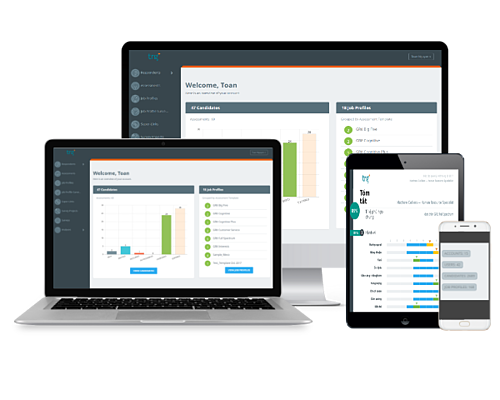360-degree feedback is often chosen as the tool of choice for many organisations to evaluate employee performance. As companies switch from traditional single-source feedback to a more comprehensive assessment method, 360-degree feedback emerges as a valuable development tool since it offers a holistic outlook on an employee’s potential, weaknesses, and improvement areas.
Moreover, the comprehensive nature of 360-degree feedback makes it an invaluable tool for identifying high-potential employees. By considering multiple viewpoints, organisations can better gauge an individual's potential for growth and advancement within the company. This allows for more effective talent management and succession planning strategies to be implemented.
By embracing this comprehensive assessment method, companies can foster a culture of continuous learning, enhance employee performance, and identify and develop top talent.
360-degree feedback, also referred to as multi-source assessment, is a performance evaluation process in which constructive feedback is gathered from various sources, such as the employee’s peers, subordinates, supervisors, and the employees themselves.
The purpose of this assessment method is to offer a comprehensive outlook on the individual’s performance, allowing them, their managers, and HR personnel to gain more insights into how others perceive them and make the necessary adjustments in their behaviours and skills to align with current business objectives and situations.
Why is 360-degree feedback vital for leadership development? Discover the reasons!
The format of 360-degree feedback varies largely from one company to another and may depend on the current position of the person being evaluated. Typically, the process requires all participants, both the feedback givers/ raters and the individual, to fill out a feedback form that comprises a series of questions.
Once the review has been done, all data will be compiled and analysed in quantitative (rating scales, scoring) or qualitative (text-based comments) methods to gain deeper insights into the differences in perspectives. After that, the results will be sent separately to each employee. This helps them understand how others perceive their performance and make adjustments if necessary.
Here is a more detailed look into how a 360-degree feedback process is typically conducted:
It is important to note that the success of a 360-degree feedback process depends on factors such as clear communication, confidentiality, trust, and a supportive organisational culture. The process should be conducted with sensitivity, emphasising its developmental nature rather than a punitive or evaluative one.
Make sure you don't miss out on these awesome tips for selecting raters in the 360-degree feedback process. Find out more >> right here <<
While 360-degree feedback can be an extremely powerful performance management tool, like any other method, it also has shortcomings. Before rolling up your sleeves and embarking on this process, it is important to familiarise yourself with both the benefits and potential challenges that may arise. Here are the pros and cons of this employee evaluation process:
Well-rounded feedback and ratings from multiple sources, including the employee’s co-workers and other people they regularly collaborate with, can provide managers with a more in-depth understanding of the individual’s strengths and weaknesses. This diverse range of perspectives allows managers to gain valuable insights into the employee's performance, work ethic, interpersonal skills, and more.
By gathering feedback from various sources, managers can utilise this valuable information to develop personalised plans and strategies to bridge potential gaps in the employee's skills and knowledge. These targeted development opportunities can further enhance each individual's professional growth.
Furthermore, by incorporating feedback from different sources, managers can gain a more objective and well-rounded perspective, reducing the potential for bias and ensuring fair evaluations. This comprehensive approach not only enhances individual growth but also promotes a more inclusive and supportive workplace culture.
360-degree feedback can encourage a more open, communicative work environment and morale among employees, regardless of their levels, by allowing them to freely express their opinions. When employees feel comfortable expressing their perspectives and ideas, it creates a work environment where innovative thinking flourishes.
Furthermore, this feedback process gives employees a clearer understanding of how their performances are being observed and recognised within an organisation, thus giving them a sense of empowerment.
Empowerment is a key aspect of building a culture of candour, and 360-degree feedback plays a significant role in this. When employees know that their opinions and contributions matter and are valued by the organisation, it boosts their confidence and motivation. This sense of empowerment fuels their passion and dedication towards their work, leading to improved morale and overall satisfaction.
The review process allows employers to identify any obstacles or challenges that may be impeding the smooth collaboration between employees and teams. It is not uncommon for conflicts, communication gaps, or a lack of clarity in roles and responsibilities to arise. 360-degree feedback can shed light on these issues and provide an opportunity for swift resolution.
By examining the feedback, employers can also uncover how company policies and procedures impact their employees' work. It is important to ensure that the enforced rules and regulations are not hindering productivity or creating unnecessary barriers.
Sometimes, policies may unintentionally create bottlenecks or prevent employees from reaching their full potential. With the insights gained from the 360-degree feedback, companies can make informed decisions and necessary adjustments to improve overall efficiency and effectiveness.
The beauty of aggregating inputs from various sources lies in the richness and depth it brings to the evaluation. Each perspective offers a unique vantage point, shedding light on different aspects of an individual's work.
Supervisors, with their deep understanding of organisational goals, can provide valuable insights into how an employee's performance aligns with the overall strategy. Co-workers, on the other hand, offer a front-line view of collaboration and teamwork, highlighting strengths and areas for improvement. And let's not forget the customers, whose feedback can be a true testament to the impact an individual has on the success of the business.
360-degree feedback may help C-level managers and executives highlight specific areas that need supplement training within the company, thus providing insight for necessary courses to improve the organisation’s collective performance.
What sets 360-degree feedback apart from traditional supervisory feedback is its reflective and validating nature. While feedback from a supervisor alone can be helpful, it may lack a broader perspective. The multi-rater process allows C-level managers and executives to see themselves through the eyes of those they work closely with, gaining a deeper understanding of their impact on the organisation as a whole.
360-degree feedback plays a pivotal role in helping employees understand and adjust their goals to align with the organisation's goals, ensuring that the entire team is moving in suitable directions.
The feedback received from different sources can shed light on any goal misalignment that may exist. For example, feedback from peers or supervisors might indicate that certain goals or behaviours are not fully in line with the organisation's strategic direction. This feedback prompts employees to reevaluate their goals and make necessary adjustments. The alignment enhances performance, goal clarity, and team cohesion, ultimately driving the overall success of the organisation.
When reviewers are inexperienced or untrained, their provided feedback can become excessively negative, positive, or too generalised and is not constructive. Moreover, with anonymous feedback, co-workers may provide stellar ratings for their favoured colleagues and negative feedback to others they dislike personally, or mutually arrange to boost each other’s ratings. Therefore, it is necessary for raters to be facilitated with sufficient training on how to give constructive feedback and ensure transparency during these evaluation processes.
Due to the nature of 360-degree feedback, many managers and executives tend to frequently examine employee’s shortcomings rather than their strengths. This may make them feel undervalued and demotivated instead of being encouraged to nurture their potential and leverage their strengths in a team.
Discover different types of biases and their effects by checking out the details >> here <<
Since 360-degree feedback is typically anonymous, employees cannot ask reviewers hy a rating was given in a certain without any explanatory comments. This could lead to a lack of clarity and raise ambiguity about the appraisal, making employees feel frustrated about follow-up actions to improve their current performance.
Thoughtful responses and insights from 360-degree feedback require considerable time and resources to aggregate. Besides, employees also need time to respond to the questions, and supervisors need extra time to sort through and assess all the collated feedback. Doing this manually is hard, but there are some available tools to help reduce the time and effort to complete these performance appraisals.
Before conducting any evaluation process, you need to clearly understand why you want to implement it. Far too many companies make changes to business processes without understanding them thoroughly, which can cause difficulties and vagueness for team members to implement.
Another common mistake in executing the 360-degree feedback method is that people misunderstand it as a replacement for face-to-face conversations. It is essential to understand that feedback and evaluation tools are not standalone solutions. Instead, they should be integrated with in-person conversations to further engage employees in the process.
Many companies indiscriminately introduce 360-degree feedback to their evaluation process to catch up with new trends in the industry and may stop using it after a few trials. This feedback model will not deliver its full potential and effectiveness unless you have strong determination and commitment to follow up with your members and make continuous improvements.
Many 360-degree feedback systems represent a radical departure from how employees traditionally give and receive feedback. Therefore, a feedback culture change should not happen immediately without notice. Instead, it requires slight changes in people’s mindsets and day-to-day behaviours. Bringing about a significant shift on short notice can be hazardous if the groundwork is not appropriately laid out.
Key stakeholders play an indispensable role from the design phase to the implementation phase of a 360-degree evaluation. Therefore, they need to be the first to be informed and included in this process in order to provide input and assist with the implementation.
Uncover 9 additional blunders commonly encountered during the 360-degree feedback process. Explore them >> here <<
It is critically important for managers and executives to identify clear goals before conducting 360-degree feedback. Keep in mind that a 360-degree assessment should be utilised mainly for developmental purposes, and its goals should be based on a SMART model (specific, measurable, achievable, relevant, and time-bound) to ensure its feasibility and reasonability.
The next important step is to provide adequate training for anyone who will participate in the evaluation process. Proper training will ensure consistency and an objective perspective in how feedback is provided.
A strength-based approach when designing a 360-degree evaluation program can bring about exponential growth for employees.
If possible, all managers and team leaders should be involved in this process to build distinctive feedback questionnaires for each department, communicate the results, and suggest development guidance for each member of the team.
After laying the foundations, let’s design the 360-degree feedback program. Ideally, your assessments should not exceed 30-40 questions to avoid survey fatigue since an employee can provide feedback to multiple co-workers.
Unleash the untapped potential of your current and future leaders, supercharge performance, and boost productivity with our cutting-edge talent management solutions, tailored to meet your specific needs today!
At TRG International, we take immense pride in presenting Great People Inside (GPI), a cloud-based assessment and survey platform designed to empower recruiters, managers, and businesses to:
By harnessing the power of GPI's advanced technology and leveraging TRG Talent's three decades of expertise, you are equipped with the perfect formula for attracting and maximising the potential of your human capital.
GPI's comprehensive 360-degree feedback assessments analyse management behaviours, uncovering how managers interact with their teams and adapt to ever-evolving market conditions.
With access to GPI's extensive library of 129 dimensions, including over 50 managerial skills and competencies, these assessments and their subsequent reports provide invaluable insights, offering tailored recommendations for future growth and development. Gain a profound understanding of your management teams and discover the most effective ways to nurture, retain, and elevate these invaluable assets.
Have a question? Don't hesitate to reach out to us now.

TRG provided great service and solutions for our recruitment and performance management process. TRG consultants are equipped with very good knowledge and have been very supportive.

Nguyen Tuan Long CapitaLand Vietnam
[TRG consultants] are devoted to supporting our HR team for the best results by thoroughly introducing the solutions, step by step guiding how to use the assessments, simplifying the guideline for users, and on-the-job training to optimise the TRG Talent products.

HR Manager FMCG Viet
IT, Talent and F&B - we think it's a great combination.
We've thrived since 1994 resulting in lots of experience to share, we are beyond a companion, to more than 1,000 clients in 80+ countries.

© 2023 TRG International. Privacy Policy / Тerms & Conditions / Site map / Contact Us
TRG encourages websites and blogs to link to its web pages. Articles may be republished without alteration with the attribution statement "This article was first published by TRG International (www.trginternational.com)" and a clickable link back to the website.
We are changing support for TLS 1.0 and older browsers. Please check our list of supported browsers.